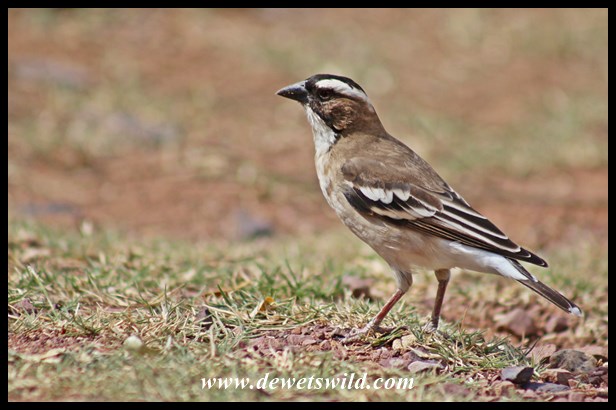Plocepasser mahali
The White-browed Sparrow Weaver is a dominant and conspicuous inhabitant of drier woodlands, thornveld, savannas and grasslands. They usually move around in small flocks of 4-10 birds, feeding on a wide variety of fruit, seeds, leaves and insects on the ground. Adults grow to 19cm in length and weigh around 50g.
White-browed Sparrow-Weavers nest in small colonies, building untidy grass nests in taller trees (including exotics) or artificial structures (like utility poles), in which they stay throughout the year. Families of White-browed Sparrow-Weavers aggressively defend their territories against intruding neighbours. Each bird in the group has its own nest, and only the dominant, monogamous, pair in the group breed. While breeding has been recorded throughout the year in response to rain, there is a definite peak in the warm summer months. Sleeping nests can be identified by having two entrances, while breeding nests have a single opening. The dominant female is responsible for incubating the clutch of 1-3 eggs for 2 weeks but the entire group assists her in the feeding of the chicks as they grow. The chicks fledge when they’re about 3 weeks old.
The IUCN describes the White-browed Sparrow-Weaver as being common to abundant and lists it is “least concern“. They occur from Ethiopia south to Angola and South Africa. In South Africa, White-browed Sparrow-Weavers are found mainly in the drier north-western parts of the country – the provinces of the Northern Cape, North West, Free State, Gauteng and Limpopo and parts of Mpumalanga and the Eastern Cape – and it would appear that they are expanding their range and increasing their numbers.






















What a pretty bird with such interesting nests! We don’t have them here so it’s great to learn about them from your blog.
LikeLike
We’re very pleased to have been able to introduce you! Thanks for the very kind feedback, Brenda!
LikeLiked by 1 person
Lovely! 🙂
LikeLike
Indeed, Annica!
LikeLiked by 1 person
I enjoy your nature photography, but my favorites are your shots of birds. Thanks for sharing.
LikeLike
As kind and generous with your comments as always. Thank you, John!
LikeLiked by 1 person
There’s really no such thing as an ordinary looking bird, is there?
LikeLiked by 1 person
Agreed Kathy – They are all remarkable!
LikeLike
Van my gunsteling voëltjies. Hulle is altyd so vrolik en opgewek. Mooi foto’s, Dries!
LikeLiked by 1 person
Dankie Dina! Ai ja, hul opgewekte sang in die vroeë oggende by Bergkwagga en Marakele sal my altyd bybly.
LikeLiked by 1 person
Such a beautiful bird.😊 Theirs nest looks very cool, I have seen some other weavers in animal channel weaves his living in a similar way. Much work.
LikeLiked by 1 person
It really is a lot of work, and often has to be done in quite a hurry after a storm has damaged their roost!
LikeLiked by 1 person
Hello. Their facial markings make them look quite fierce little birds. They really are organised to have separate nests for sleeping and breeding. I haven’t seen these in KZN but have in KNP. Great photos.
LikeLiked by 1 person
Thanks Kim! You can consider yourself very lucky to have seen them in Kruger as they are not very common in the lowveld!
LikeLike
I saw them in and around Satara Camp, but that was 27 years ago!
LikeLike
What a pretty bird, and I love the nests!
LikeLiked by 1 person
And you should hear their beautiful song, especially at sunrise!
LikeLiked by 1 person